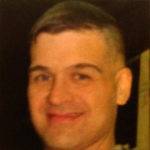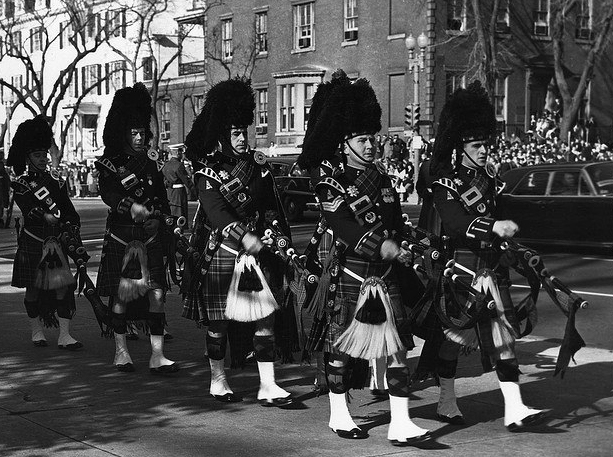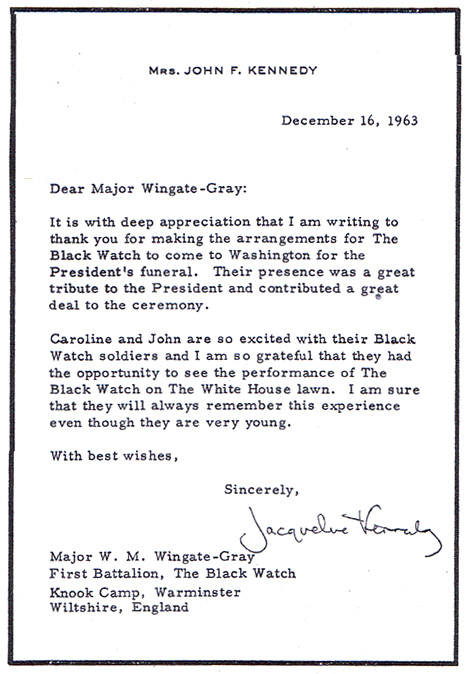 We continue with the feature by Lt Col Robert Keith Gunther on President John F Kennedy and his association with the bagpipe and pipe bands. Lt Col Gunther now looks in detail at the State Funeral that followed the much-loved President’s tragic assassination 51 years ago in Dallas, Texas, this weekend.
We continue with the feature by Lt Col Robert Keith Gunther on President John F Kennedy and his association with the bagpipe and pipe bands. Lt Col Gunther now looks in detail at the State Funeral that followed the much-loved President’s tragic assassination 51 years ago in Dallas, Texas, this weekend.
According to the ‘Personal Memoirs of the State Funeral of JFK, November 22-25, 1963’, Private First Class Arthur A. Carlson, who led the riderless horse during the funeral, heard that HRH Prince Phillip commented that there was no need to hurry to get to the USA from London to attend as ‘it would take at least two weeks to plan and execute such a funeral’. This massive and ornate state funeral was executed significantly quicker than Prince Phillip’s best guess – at the behest of those actually participating in it.
Capt. Thomas F. Reid, the 26-year-old Company Commander of Delta Company, 3rd US Infantry, and (The Old Guard), stated that ‘The Military District of Washington (MDW) had a master plan for conducting a State Funeral, but we never rehearsed the funeral of the incumbent president, so no specific plan had been formulated for him. We only had the basic master plan to work with as a template.’
As a result, the state funeral preparations were highly accelerated and chaotic – with almost hourly changes to the plan, including the late-breaking addition of two piping elements into the ceremony. Captain Reid stated that when ‘the Air Force Bagpipe Band was given a role in the ceremony I had to find a way to fit them into the sequence of events. At the last minute, I was told to expect the arrival of a nine-man detachment from the British Black Watch Regiment, and to fit them into the ceremony some place.’
 A key point to note is that varying memories exist of the state funeral, because no two participants in it had the same view. This must be taken into account when reading through the multiple sources available. This is a possible explanation for the misleading collective memory of the time.
A key point to note is that varying memories exist of the state funeral, because no two participants in it had the same view. This must be taken into account when reading through the multiple sources available. This is a possible explanation for the misleading collective memory of the time.
The entire funeral plan is detailed in ‘The Last Salute: Civil and Military Funerals, 1921-1969’. Chapter 23 covers the State Funeral of President Kennedy from 22-25 November 1963. The funeral Order of March was from the U.S. Capital Building to the White House thence to St. Matthew’s Cathedral and Arlington National Cemetery, Washington DC.
The Black Watch

Piper Bruce Cowie and the rest of the Black Watch band – still on tour in the US – were approaching their hotel when news came through of the assassination. ‘It was surreal,’ said Bruce. ‘The band’s evening performance was called off out of respect.’ Subsequent tour performances and tunes were altered to better reflect the national state of mourning.
According to the Red Hackle Magazine [the regimental magazine], immediately after the assassination, the Black Watch band performed a small public tribute to JFK in Knoxville, Tennessee. Pipe Major James Anderson played Flowers of the Forest and the band followed with the American National Anthem. The tribute was initiated with a short speech by the officer commanding, who said the regiment were ‘offering our empathy to the American people and associating ourselves with them at this time’.
On 24 November 1963, the Pipe Major and eight pipers flew from Knoxville to Washington DC and were met by Mr. R.C. Robertson of the British Army staff. The nine-man Black Watch contingent was invited to march in JFK’s funeral procession by Jackie Kennedy, who remembered how much JFK had enjoyed the South Lawn performance, his last happy day.
As stated in the ‘Last Salute’: ‘After the final plans were drafted on 24 November, only one more change was made in the composition of the procession to St. Matthew’s Cathedral: a small contingent of bagpipers, the Black Watch of the Royal Highland Regiment, was to join the procession at the White House. This unprecedented participation of a foreign unit in the funeral for a President of the United States was the result of another of Mrs. Kennedy’s requests. The pipers were to fall in behind the Marine Company at the rear of the military escort.’
Piper Bruce Cowie confirmed that some of the pipers marched with cuts and bruises from a bar fight in Kentucky where they defended JFK’s honour on the evening of the assassination. Black Watch pipers were at a bar when several (probably pro-segregation) Americans starting toasting JFK’s assassination. Piper Bruce Cowie stated, ‘There were a few of the pipe band and also several of the military band that did get involved, and a few did require hospital treatment.’
The White house to St. Matthew’s Cathedral
The Black Watch pipers were in the third Order of March behind a company of U.S. Marines. They were the 24th element out of 32 that made up the funeral procession. The BW joined it near the northwest gate of the White House when the funeral procession stopped there. The BW pipers left the funeral procession immediately after the service at St. Matthew’s Cathedral. Red Hackle magazine mentions that, ‘It was bitter cold in Washington that day, with a wintry wind sweeping the wide avenues. The party had to wait two hours outside the White House for the procession to arrive (from the Capital building), by which time fingers were fast becoming numb and frozen.’
Piper Cowie stated: ‘It is a hard thing to explain how I felt at the time. It was only later, afterwards, that there’s a realisation of what happened. You just realize you were part of history. The Kennedys as a family seemed to have a nice touch.’
Irving Lowen wrote in his article ‘Accurate Listing of Funeral Music’ that at, ’11:40 a.m the cortege leaves the White House for St. Matthew’s Cathedral. The music was provided by nine pipers from the Black Watch of the Royal Highlanders Regiment, who played The Brown Haired Maiden, The Badge of Scotland, The 51st Highland Division, and the Barren Rocks of Aden. Other tunes reported to have been played included the Green Hills of Tyrol, When the Battle’s Over, and Old Rustic Bridge. Lowen added that the pipe tunes played ‘were identified by Pipe Major Anderson of the Royal Highland Regiment through Mr Derek Day of the British Embassy.’
Private First Class (PFC) Arthur A. Carlson commented on the funeral procession from the White House to the cathedral, ‘At one point bagpipes [from the Black Watch] played. I had trouble getting the beat, but once I learned to march with the music it gave me a burst of energy. That is music to fight by.’ PFC Carlson went on to add that the march from the cathedral to the cemetery was the longest march segment of the state funeral. Estimated at three to four miles long, mourners lined the route from the cathedral to the gates of Arlington National Cemetery. ‘I remember I thought I had seen it all, with the thousands of mourners at the capital; however, that was nothing compared to this. It was also an eerie sensation that except for a few shouts of encouragement from the crowd, there was absolutely no noise except for the deafening sound of drums. I was haunted by the sound of drums for days after the funeral,’ commented Carlson.

Piper Bruce Cowrie, of Kirriemuir, Angus, was 24 in 1963. He recently travelled to London to play alongside opera singer Alfie Boe to mark the 50th anniversary of the assassination. Bruce has now given up playing the pipes and his last performance was at a recent family wedding. Major Ronnie Proctor, Black Watch Association secretary said: ‘Bruce is the lasting connection of The Black Watch to the whole series of events. It is a great honour that a foreign country’s pipers and servicemen were allowed to take part in an overseas head of state’s funeral. It’s pretty unique.’
According to the Brechin Advertiser’s article, ‘Brechin-born Pipe Major who Helped Mourn JFK’, Piper Charles Clark is also believed to have come up with a score that eventually became one of Scotland’s best known tunes, Amazing Grace. He entered the Black Watch before completing his apprenticeship and began what was to prove to be a highly rewarding military career which would continue later in the Royal Scots. Another significant musical contribution was a tune Clark wrote for Princess Anne’s wedding. The article states that he died in 2001.
The Black Watch Officer Commanding during the tour and the funeral, Michael Wingate-Gray, died in November 1995. After the BW he went on to become a Brigadier General and the commanding officer of the SAS. Pipe Major James B. Anderson died in 2004.
Tune Selection
During the funeral procession, the Black Watch contingent didn’t play the normal repertoire associated with standard military funerals, but instead played tunes featured during the South Lawn Performance that were specifically requested by the White House.
[easyrotator]erc_14_1414056032[/easyrotator]In the BBC article, ‘the Black Watch Piper who played at Kennedy’s Funeral’, Bruce Cowie stated that ‘the tune choice did not reflect the music the band would normally play at a funeral, and the Black Watch piping contingent struggled to keep time with their US counterparts. As far as we were concerned, it was a bit of a debacle. ‘We were flown from Kentucky and went to an American Air Force base. We spent two-and-a-half hours doing the funeral marches, Flowers of the Forest, Land of the Liel, and all that stuff. Then our pipe major came in and he was livid – to say he was unhappy was to put it mildly. The bonnet went flying into the corner and he said, ‘you can forget it. They don’t slow march; they do what you call ‘trail arms’ – which means they are faster than we are. ‘
‘The pipe major was caught short and nobody was happy with the tunes we had to play because they weren’t what we would say was in keeping with a funeral. They weren’t even slow marches. On reflection, if the pipe major had been given more time, he could have come up with better tunes, but they were picked by the Americans. We weren’t happy about it, but the Americans seemed to enjoy what we played.’
Piper Cowie’s comments are detailed in a Daily Record article ‘Last surviving member of pipe band at JFK’s funeral tells of row over service music’. The Red Hackle magazine states that, ‘the funeral pace was laid down as 100 paces to the minute, which accords neither with our funeral march nor with any British marching step. ‘The Pipe Major had to thus sit down and practice with his pipers that night (November 24, 1963) in a selection of 4/4s and 4/2s [misprint – should have read 2/4s] to obtain the right speed.’
The Black Watch participation in the JFK State funeral can be seen at: http://www.youtube.com/watch?v=14Dl4ytKpq0
Immediately following the state funeral, on November 25, 1963, the pipers flew to Lexington, Kentucky, and rejoined the rest of the tour for a performance that night. The commanding officer spoke with the local sponsors for an hour and a half as well as the British Embassy in Washington on whether to perform that night on a national day of mourning. It was decided to go ahead and a large audience assembled and a second tribute to JFK ‘went down excellently’ according to Red Hackle magazine.

In keeping with her impeccable etiquette, Mrs. Kennedy sent a thank you letter to Major Wingate-Gray on December 16, 1963. She stated that the pipers ‘presence was a great tribute to the President and contributed a great deal to the ceremony’. She also thanked the Black Watch for sending two Black Watch toy soldiers to the Kennedy children for John’s birthday, which occurred on the day of the state funeral, and for Caroline’s, which occurred two days afterwards. The children had their birthday party together shortly after the state funeral was concluded. The thank-you letter (above) is distinctly different in that the White House logo is replaced simply by Mrs. John F. Kennedy.
This series concludes with a look at the role played by US Air Force Pipe Band in the ceremony. Stay tuned to pipingpress.com.



















Excellent article and proud to serve with the Black watch on subsequent tours in USA, this event was never far from conversation with all US citizens that we met. As a point of detail – the youtube clip is not completely accurate as the sound is dubbed from a recording and not what was played on the day. This is evident as you can clearly hear drums playing, there were no drummers at the funeral, only 9 pipers. I have spent many hours trying to find footage that is more accurate, without success! Best regards, Stevie Small